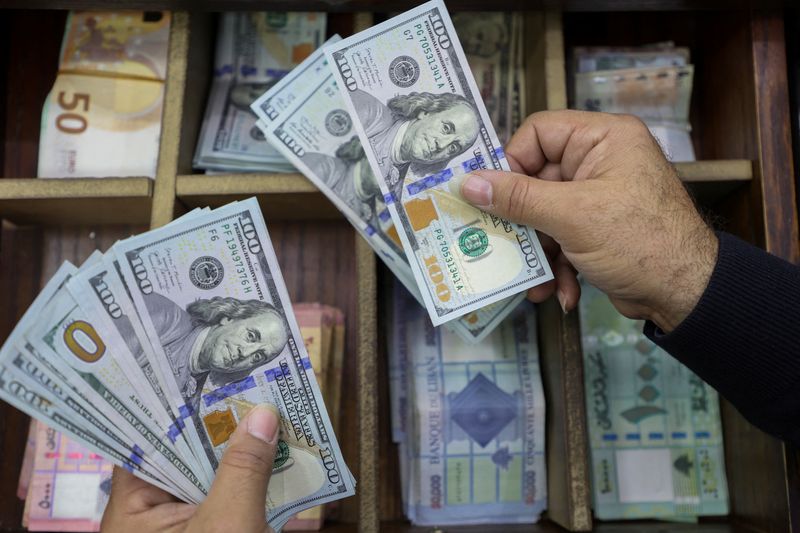Forex
Dollar extends fall, euro and yuan jump after Trump comments on tariffs

By Stefano Rebaudo
(Reuters) -The U.S. dollar dropped and bitcoin hit an all-time high on Monday before Donald Trump’s inauguration as U.S. president later in the session, with investors focusing on policy announcements that could immediately affect the greenback.
The yen dropped slightly, but clinging to a one-month high touched on Friday, as traders wager that the Bank of Japan will hike its policy interest rate this week.
Trading volume was expected to be thin due to U.S. markets being closed for the Martin Luther King Jr. Day holiday.
Softer U.S. inflation data and the prospect of multiple Federal Reserve rate cuts have recently boosted risk assets, including , which hit a record high on Monday at $109,071.86 and was last up 4.2% at $107,120.
Trump has promised to be a “crypto president”, and is expected to issue executive orders aimed at promoting widespread adoption of digital assets.
Some analysts now feared that delays in the U.S. administration implementing measures could trigger a “sell the news” reaction, potentially disrupting the positive momentum.
Investors’ attention was firmly fixed on the policies Trump will enact on his first day in office. At a rally on Sunday, Trump said he would impose severe limits on immigration.
Goldman Sachs strategists expect further potential 5% dollar upside in their base-case over the next few months, but cautioned about near-term risks due to the market’s expectations for swift action on tariffs.
The , which measures the U.S. currency against six peers, was 0.36% lower at 109.02. It hit last week a 26-month high of 110.17.
“There are high expectations of Trump announcing trade tariffs under executive order along with many other policy announcements that could prompt further U.S. dollar gains,” said Derek Halpenny, head of research global markets at MUFG.
The greenback has risen 4% since the November presidential election as traders anticipate Trump’s policies will boost growth and inflation.
“There will be the risk of a correction in the dollar should it look like Trump will be more selective on tariffs – but that should probably come at a later stage,” said Chris Turner head of global forex strategy at ING, after mentioning remarks about tariffs as negotiating tools by Scott Bessent, U.S. Trump’s choice to head the Treasury Department.
TARIFF THREATS
The euro advanced 0.48% to $1.032. It hit last week a two-year low at $1.0177 as tariff threats weighed.
“If International Emergency Economic Powers Act (IEEPA) is invoked for trade, markets should see that as a strong statement of intent that the U.S. is planning large-scale tariffs,” said Sjay Rajadhyaksha, research analyst at Barclays (LON:).
IEEPA is a federal law in the United States that grants the President the authority to regulate economic transactions in response to unusual and extraordinary threats.
On the fiscal front, “we will be watching to see if President Trump mentions fiscal stimulus”, Rajadhyaksha said.
The yen was last at 156.34 per dollar, after hitting a one-month high of 154.98 on Friday, with sources telling Reuters the BOJ was likely to raise its policy interest rate this week barring market shocks when Trump takes office.
Markets will focus on clues for the rate outlook as money markets pricing implied an 80% chance of a 25 basis-point (bps) rate hike and 50 bps by year-end. [IRPR]
rose on Monday to its highest against the dollar since Jan. 3 buoyed by a friendly call between Trump and Chinese President Xi Jinping on Friday and better-than-expected fourth-quarter economic data.
The hit 7.3190 per dollar and was last up 0.27% at 7.3214.

It has outperformed most of its peers since the U.S. elections, despite expectations for strong U.S. tariffs, as the People’s Bank of China has continued efforts to maintain currency stability.
China’s central bank told Reuters late on Friday it is confident it can keep the yuan exchange rate “basically stable” at a “reasonable and balanced” level.

 Forex3 years ago
Forex3 years agoForex Today: the dollar is gaining strength amid gloomy sentiment at the start of the Fed’s week

 Forex3 years ago
Forex3 years agoUnbiased review of Pocket Option broker

 Forex3 years ago
Forex3 years agoDollar to pound sterling exchange rate today: Pound plummeted to its lowest since 1985

 Forex3 years ago
Forex3 years agoHow is the Australian dollar doing today?

 Cryptocurrency3 years ago
Cryptocurrency3 years agoWhat happened in the crypto market – current events today

 World3 years ago
World3 years agoWhy are modern video games an art form?

 Commodities3 years ago
Commodities3 years agoCopper continues to fall in price on expectations of lower demand in China

 Economy3 years ago
Economy3 years agoCrude oil tankers double in price due to EU anti-Russian sanctions


























